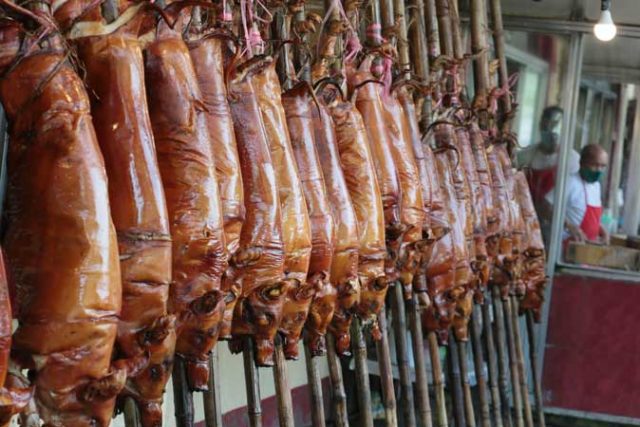So, what were we eating before Magellan came?

SOME 500 years ago, explorer Ferdinand Magellan landed on the shores of an island in the Visayas. From there, he went to Cebu, converted its leader, Rajah Humabon, and then some 300 years’ worth of colonial history is recorded after that.
The discussion of food often takes a backseat in history, seeing it as marginal to the events and people that shape it. However, food in itself is a story: it points to a region’s ability to produce, move, trade, and share (among other things).
Cebu-based historian Louella Alix was the speaker at a talk by Gabii sa Kabilin, a heritage initiative by the Ramon Aboitiz Foundation, Inc. The July 30 talk, titled “From Sutukil to Kumbira: 300 Years of Culinary History during the Spanish Colonial Period,” discussed not just that, but also the precolonial civilization (and its way of eating) that the colonizers encountered.
Ms. Alix pointed out the origins of the word sutukil (the name of a popular restaurant). It is a portmanteau from three precolonial cooking methods: sugba (roasting over live coals), kilaw (eating meat raw with vinegar and spices), and tuwa or tinuwa (cooking with liquid). “Some wise guy in the ’80s or ’90s started opening his restaurants and called it ‘Sutukil’ (a pun on the grisly phrase ‘shoot-to-kill’),” she said. “Which [of the dishes] was the first?” Though the abbreviation places “sugba” as first, Ms. Alix believes that precolonial Filipinos served their earliest meals as kilaw. “Everybody ate raw or semi-raw food, not knowing what to do better,” she said. Sugba may have come later, but she’s firm that at least in those times, tuwa (or soup) pointed to the most advanced cooking method. “To cook with liquid is something that requires technology,” she said. That meant that those early people had to make vessels to cook in, with Filipinos using clay pots. “To knead and to mold clay means that people had time, means, and brains to think of producing the item.”
She pointed to an archaeological dig in Northern Cebu by the University of San Carlos and the National Museum which found jars and clay pots. The bigger jars were used for secondary burials, while the clay pots performed more prosaic tasks for the home, like cooking and storage. These were sent to the US for dating; and they were dated to have been made around the Iron Age (approximately 12,000 to 600 BC). “That means that there was already a civilization in Cebu during the Iron Age,” she said. “At that time, the Chinese had not even been to our shores. Europeans were still huddled in caves.”
On that note, she also pointed to a linguistic difference in “sugba” and “asal (as in inasal).” Sugba is roasting just pieces of meat, while asal meant roasting the whole animal. Cebu lechon (a whole roasted pig), a famous delicacy, began to be called so only after Hispanicized Tagalogs settled in Cebu, lending them the word.
She noted that Filipinos had mostly failed to adopt the spicier cuisines of our Southeast Asian neighbors, though we do have a similar preference for coconut milk.
In any case, she thanked Antonio Pigafetta, Ferdinand Magellan’s chronicler, for writing everything down. “Most of our knowledge of precolonial life in Cebu, we owe to [him],” she said.
According to her, the natives back then served the Spanish explorers tinuwa (pork with soup), grilled pork and fish, and Pigafetta recorded that fish was also eaten raw (kinilaw). She also mentioned a version of adobo, which made the Spaniards marvel that it was similar to something they also made at home (that is, stewed in lard and vinegar; which was how we got to give it a Spanish name). She also listed down the meats used for feasts and meals, as recorded by Pigafetta: deer, pigs, shrimp, crab, wild boar, chicken, carabao, and fish.
Because Magellan perished in the Battle of Mactan, the Spanish influence on our cuisine would not be seen until some 40 years later, after the landing of Miguel Lopez de Legazpi, who eventually came to sit as the first Spanish Governor of the Philippines and established Manila as the island groups’ capital.
Ms. Alix listed down vegetables and fruits which we have since taken for granted, but were actually transplants from the Galleon Trade: these included tomatoes, sayote, chico, pineapple, camote, and jicama. The Galleon Trade also brought cacao here, known and enjoyed by Cebuanos as sikwate (which itself comes from the Nahuatl word xocolatl, the root for “chocolate”).
A non-cooking aspect of Spanish colonization led directly to some of the sweetest of Pinoy dishes. Construction of Spanish churches, which used coral stones from the sea, were strengthened by a binder called agramasa, using tree sap from the law-an, lime, and egg whites. “Can you imagine how many egg yolks were collected?” said Ms. Alix. “Surely the housewives then would not have thought of wasting all these egg yolks.” This construction method led to the creation of leche flan, tortas, tocino del cielo, and yema.
The Spaniard taught us stewing techniques, with ingredients brought over from Spain and its colonies: tomatoes, olive oil, chickpeas, and peppers. Nuns, and friars’ cooks meanwhile, taught the cooking methods to local assistants or students, which was how stews and baked goods (broas, still popular in Cebu, being one of them) spread around the islands.
Ms. Alix did point out that Pigafetta noticed cakes made of cooked millet — one still present on Cebuano tables as budbud kabug. Luckily for us, a lot of the precolonial meals were preserved, mostly due to a practical reason: “The Spanish dishes… are not served for daily fare. We have relegated it to fiestas and celebrations, as it is expensive to cook them.” — Joseph L.Garcia



